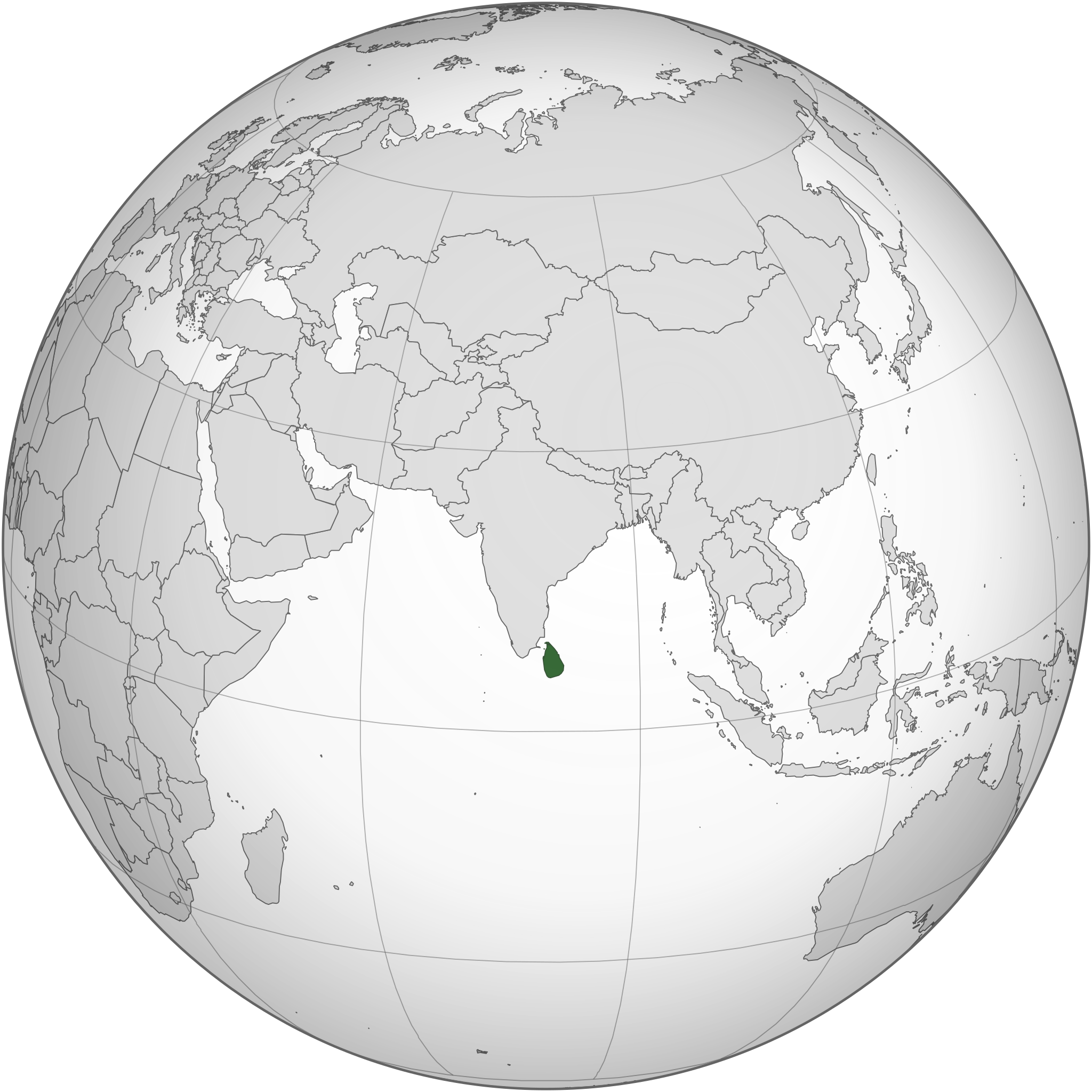| Democratic Socialist Republic of Sri Lanka ශ්රී ලංකා ප්රජාතාන්ත්රික සමාජවාදී ජනරජය இலங்கை சனநாயக சோசலிசக் குடியரசு | |
|---|---|
|
Flag | |
 | |
| Largest city | Colombo |
| Official languages | Sinhala Tamil |
| Dominant mode of production | Capitalism |
| Government | Unitary Bourgeois Republic |
| Area | |
• Total | 65,610 km² |
| Population | |
• 2020 estimate | 22,156,000 |
Sri Lanka, officially the Democratic Socialist Republic of Sri Lanka and formerly known as Ceylon, is an island country in South Asia. In spite of its offical name, it is not a socialist state.
History
Ancient history
Tamils and Sinhalese have lived in Sri Lanka for thousands of years. Around 500 BCE, Prince Vijaya and the ancestors of the Sinhala arrived from India.[1] In the first century CE, the Anuradhapura Kingdom had an ambassador to the Roman Empire. The island was united under one kingdom in the 11th century but was divided into three kingdoms by the time the Portuguese arrived in 1505.[2]
Colonization
In 1619, the Portuguese annexed the Jaffna Kingdom after defeating its king and forced the native population to convert to Catholicism.[2] In 1638, the Dutch defeated the Portuguese and conquered most of the island by 1660. In 1796, the island was conquered by the British and became a Crown colony in 1802.
In 1815, the Kingdom of Kandy was defeated the British and it became a British dependency after a rebellion in 1818. and In the 1830's, the British began bringing laborers from Tamil Nadu in southern India to work on coconut, coffee, and tea plantations. In 1919, the Ceylon National Congress was founded by Arunachalam Ponnambalam, who quit in 1921 because he believed the CNC only represented Sinhala and not Tamils. In 1948, Sri Lanka gained independence from Britain.[1]
Independence
After independence, many Tamil plantation workers were disenfranchised. In 1949, the Tamil Federal Party was formed and advocated for regional autonomy for the Tamils.[1] In 1956, the United National Party established Sinhala as the sole official language of Sri Lanka, causing tens of thousands of Tamil speakers to lose their jobs. In 1976, the Tamil United Liberation Front adopted a resolution to establish a separate Tamil state called Tamil Eelam, which was supported by over 90% of Tamils on the island. In the early 1980's, an amendment to the constitution was passed that criminalized separatism and the TULF. During Black July of 1983, 53 Tamil political prisoners were detained under maximum security[3] and thousands of Tamils were killed in pogroms and by the state.[1]
Tamil Tigers
The Liberation Tigers of Tamil Eelam, an armed Tamil nationalist organization, fought against the Sri Lankan government from 1983 to 2009 and established a de-facto state in the northeast. They established their own banks, courts, police, taxation system, and shipping fleet.[3] In 1987, India signed the Indo-Sri Lanka Accord and sent 140,000 troops to support the Sri Lankan government. In March 1990, the Indian troops withdrew and there was a temporary truce, which was broken in June. In 1995, the People's Alliance was elected to power and signed a ceasefire with the LTTE that lasted three months. In 1999, the LTTE launched a counteroffensive, recapturing lost territories and killing over 1,200 enemy soldiers in just three days. In 2002, peace talks were held in Thailand and a ceasefire lasted until 2006, when the Sri Lanka Air Force launched an offensive and began capturing territory. The LTTE was liquidated in 2009 after its leader, Velupillai Prabhakaran, was killed.[1]
2022 protests
Mass protests began in April 2022 against President Gotabhaya Rajapakse due to IMF austerity measures. Sri Lanka had a large foreign debt, 79% of which was owed to the United States, Europe, and Japan. Only 10% of Sri Lanka's debt was owned by China and 2% was owned by India.[4] By July, the protests had grown to a million people and forced Rajapakse and Prime Minister Ranil Wickremesinghe to resign.[5]
Demographics
73% of Sri Lanka's population are Sinhalese, who speak an Indo-Aryan language and mainly practice Buddhism. The other large ethnic group is the Tamils, who make up 18–21% of the population and speak a Dravidian language. The Tamils include Sri Lankan Tamils who have lived on the island for thousands of years as well as Indian Tamils who were brought to Sri Lanka as plantation laborers by the British in the 19th century. There are also Tamil-speaking Moors who are descended from Arabs and Burghers who are descended from early Dutch settlers.[2]
References
- ↑ 1.0 1.1 1.2 1.3 1.4 Ravindran (2009). Tamil Eelam Struggle and its Lessons. [PDF] People's Truth.
- ↑ 2.0 2.1 2.2 "#77 - Sri Lanka - the poisoned legacy of British colonial rule". International Communist Union. Archived from the original on 2020-11-21. Retrieved 2022-06-16.
- ↑ 3.0 3.1 Surendra (2010-11-18). "Sri Lanka: Lessons of the defeat of the Tamil Tigers" Revolutionary Initiative. Archived from the original on 2021-01-20.
- ↑ Ben Norton (2022-07-11). "Real debt trap: Sri Lanka owes vast majority to West, not China" Multipolarista. Archived from the original on 2022-07-18. Retrieved 2022-07-29.
- ↑ Deepal Jayasekera (2022-07-10). "Sri Lankan uprising forces resignation of president and prime minister" World Socialist Web Site. Archived from the original on 2022-07-11. Retrieved 2022-07-11.
